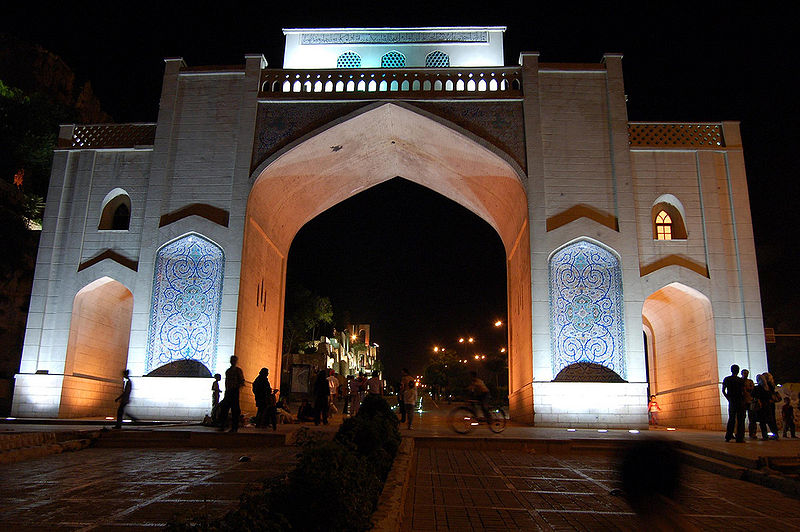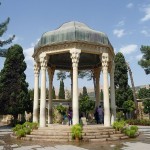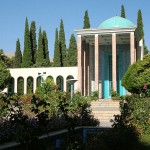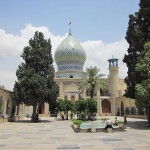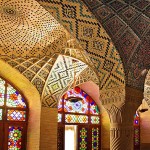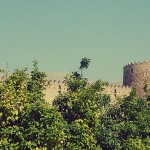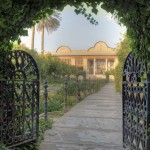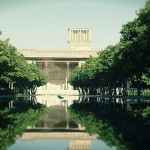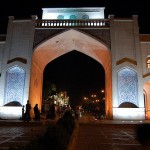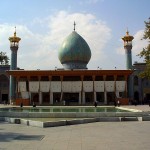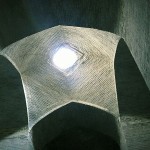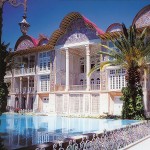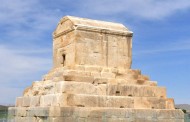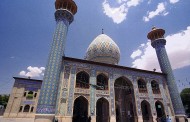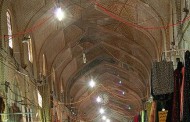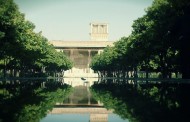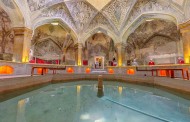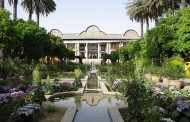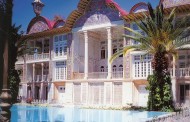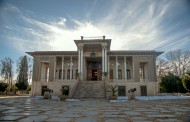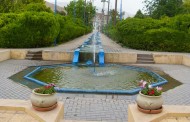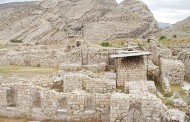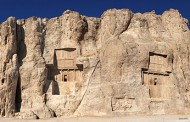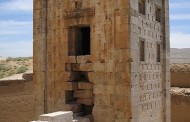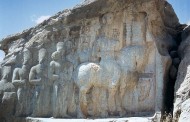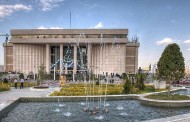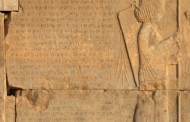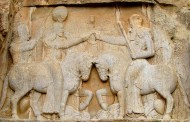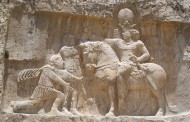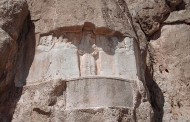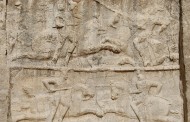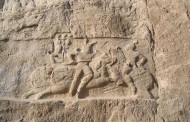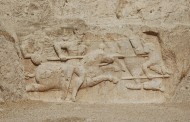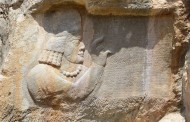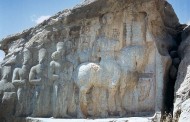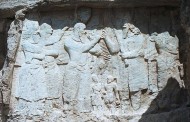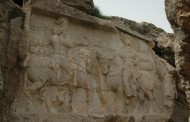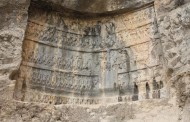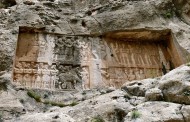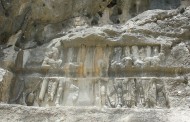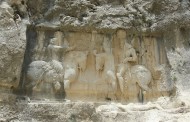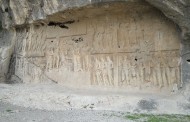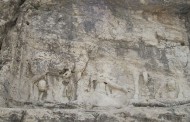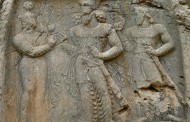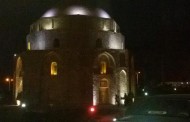Shiraz is the sixth most populous city of Iran and the capital of Fars Province (Old Persian as Pârsâ). In 2009, the population of the city was 1,455,073. Shiraz is located in the southwest of Iran on the Roodkhaneye Khoshk (Dry River) seasonal river. It has a moderate climate and has been a regional trade center for over a thousand years. It is regarded as one of the oldest cities of ancient Persia.
The earliest reference to the city, as Tiraziš, is on Elamite clay tablets dated to 2000 BC. In the 13th century, Shiraz became a leading center of the arts and letters, due to the encouragement of its ruler and the presence of many Persian scholars and artists. It was the capital of Persia during the Zand dynasty from 1750 until 1781, as well as briefly during the Saffarid period. Two famous poets of Iran, Hafez and Saadi, are from Shiraz.
Shiraz is known as the city of poets, literature, wine and flowers. It is also considered by many Iranians to be the city of gardens, due to the many gardens and fruit trees that can be seen in the city. Shiraz has had major Jewish and Christian communities. The crafts of Shiraz consist of inlaid mosaic work of triangular design; silver-ware; pile carpet-weaving and weaving of kilim, called gilim and jajim in the villages and among the tribes. In Shiraz industries such as cement production, sugar, fertilizers, textile products, wood products, metalwork and rugs dominate. Shirāz also has a major oil refinery and is also a major center for Iran’s electronic industries: 53% of Iran’s electronic investment has been centered in Shiraz. Shiraz is home to Iran’s first solar power plant. Recently the city’s first wind turbine has been installed above Babakoohi mountain near the city.
- Tomb of Hafez
- Tomb of Saadi
- Imamzadeh ye Ali ebn e Hamze
- Nasir ol Molk Mosque
- Stained glass windows in Arg of Karim Khan
- Qavam House
- Arg of Karim Khan
- Quran Gate
- Shah Cheragh
- Vakil Water Storage
- Eram Garden
Attractions
- The tombs of Hafiz , Saadi, and Khaju e Kermani (whose tomb is inside a mountain above the city’s old Qur’an Gate). Other lesser known tombs are that of Shah Shoja’ (the Mozafarid emir of Persia, and patron of Hafiz), and the Haft Tanan mausoleum, where 7 Sufi mystics are buried. The Tomb of Baba Kuhi sits atop a mountain overlooking the city, and the tomb of Karim Khan Zand is at the Pars Museum of Shiraz.
- The oldest mosque is Atigh Jame’ Mosque, which is one of the older mosques of Iran, followed by Vakil Mosque and Nasir al-Mulk mosque. The Vakil Mosque is situated west of the famous Vakil Bazaar. It covers an area of 8,660 square meters and was built in 1187 (AH) during Zand Dynasty. On the two sides of the entrance gate there are magnificent tile-works and arches. The left and right corridors of the entrance gate are connected to the main room.
- Šāh Čerāq Mosque
- The citadel of Arg of Karim Khan sits adjacent to the Vakil Bazaar and Vakil Bath at the city’s central district. The most famous of houses are Zinat-ol-Molook House and Gahavam’s House, both in the old quarters of the city.
- The Qur’an Gate is the entrance to Shiraz. It is located near the gorge of Allah-o-Akbar and is flanked by the Baba Kuhi and Chehel Maqam mountains. The gateway is where two copies of the Qurans known
- The Eram Garden (Bagh-e Eram) in Shiraz is a striking location for visitors with a variety of plants as well as a historic mansion. Although the exact date of the construction of the garden is not clear, historical evidence suggests it was constructed during the Seljuk Dynasty on the orders of the celebrated Seljuk monarch Sanjar. Other historical Persian gardens are Afifabad Garden and The Museum of Weapons, Delgosha Garden and Jahan nama Garden.
Within a relatively short driving distance from Shiraz are the ruins of Persepolis, Bishapur, Pasargadae, and Firouzabad. At Naqsh-e Rustam can be found the tombs of the Achaemenid kings as well as the Ka’ba-ye Zartosht, which has been thought to be either a Zoroastrian fire temple or possibly even the true tomb of Cyrus the Great. Maharloo Lake is a popular breeding ground for various bird species.
Naqsh-e Rostam site contains funerary related works belonging to the Elamite (second millennium BCE), Achaemenid (550–330 BCE) and Sassanid (226–651 CE) eras. Naqsh-e Rostam is a site believed by archaeologists to have been a cemetery for Persepolis, where Achaemenid, Parthian and Sassanid royalty were laid to rest.
Naqsh-e Rajab is an archaeological site just east of Istakhr and about 12 km north of Persepolis.
Shopping
The Persian Gulf Complex, located at the north end of the city, is the largest mall in the world in terms of the number of shops.
TOP SIGHTS IN SHIRAZ
Pasargadae
Pasargadae was the first dynastic capital of the Achaemenid Empire, founded by Cyrus II the Great, in Pars, homeland of the Persians, in the 6th centu... Read more
Persepolis
Founded by Darius I in 518 B.C., Persepolis was the capital of the Achaemenid Empire. It was built on an immense half-artificial, half-natural terrace... Read more
Tomb of Hafez
The Tomb of Hafez and its associated memorial hall, the Hāfezieh, are two memorial structures erected in the northern edge of Shiraz, Iran, in memory... Read more
Qur’an Gate
Qur’an Gate (Persian: Darvāzeh Qur’an) is a historic gate in the north of Shiraz, Iran. It is located at the northeastern entrance of the... Read more
Pars Museum
The Pars Museum is a museum in Shiraz, Fars Province, southern Iran and is located in Nazar Garden. The octagonal building was the place in which roya... Read more
Atigh Jame’ Mosque
Atigh Jame’ Mosque is a 9th-century mosque in Shiraz. Read more
Vakil Mosque
The Vakil Mosque (Persian: Masjed-e Vakil) is a mosque in Shiraz, southern Iran, situated to the west of the Vakil Bazaar next to its entrance. This m... Read more
Nasir ol Molk Mosque
The Nasir ol Molk Mosque (Persian: Masjed e Nasir ol Molk), also known as the Pink Mosque, is a traditional mosque in Shiraz, Iran. It is located at... Read more
Vakil Bazaar
Vakil Bazaar is the main bazaar of Shiraz, Iran, located in the historical center of the city. It is thought that the market originally was establishe... Read more
Shah Cheragh
Shāh Chérāgh is a funerary monument and mosque in Shiraz, Iran, housing the tomb of the brothers Ahmad and Muhammad, sons of Mūsā al-Kādhim and broth... Read more
Arg of Karim Khan
Arg of Karim Khan (Persian: Arg-e Karim Khan) is a citadel located in the downtown Shiraz, southern Iran. It was built as part of a complex during th... Read more
Vakil Bath
Vakil Bath is an old public bath in Shiraz, Iran. It was a part of the royal district constructed during Karim Khan Zand’s reign, which includes... Read more
Qavam House
Qavam House (also widely called “Narenjestan e Ghavam“) is a traditional and historical house in Shiraz, Iran. It is at walking distance f... Read more
Eram Garden
Eram Garden (Persian: Bāq e Eram) is a historic Persian garden in Shiraz, Iran.The garden, and the building within it, are located at the northern sh... Read more
Afif-Abad Garden
Afif-Abad Garden (Persian: Bāq e Afif-Ābād), originally the Golshan Garden (Persian: Bāq e Golshan), is a museum complex in Shiraz, Iran. Located i... Read more
Delgosha Garden
Delgosha Garden is one of the historical gardens in Shiraz, Iran near Tomb of Sa’di and it belongs to the pre-Islamic era of the Sassanian Empire. In... Read more
Naqsh-e Rustam
Naqsh-e Rustam (Persian: Naqŝe Rostam Persian pronunciation: [næɣʃeɾosˈtæm]) is an ancient necropolis located about 12 km northwest of Persepolis, in... Read more
Ka’ba-ye Zartosht
The Ka’ba-ye Zartosht (alt: Kaba-ye Zardusht, Kaba-ye Zardosht, ), meaning the “Cube of Zoroaster,” is a 5th century B.C.E. Achaeme... Read more
Naqsh-e Rajab
Naqsh-e Rajab (Persian: Naqŝe Rajab, Persian pronunciation: [næɣʃeɾæˈd͡ʒæb]) is an archaeological site just east of Istakhr and about 12 km north of... Read more
Persian Gulf Complex
Persian Gulf Complex is a large shopping mall located in Shiraz, Iran.It is the biggest mall in terms of the number of shops. The facility has space f... Read more
Tomb of Saadi
Tomb of Saadi , reputated to “Saadiyeh” is mausoleum of the Persian poet Saadi in Shiraz , Iran. It’s located beside the Delgosha Garden. Saadi was... Read more
Emamzadeh Ali Ibn Hamzeh
Emamzadeh Ali Ibn Hamzeh is a monument in Shiraz , Iran . It’s mausoleum of Shah Mir Ali Ibn Hamzeh Ibn Musa Kadhim . The mausoleum built in the Dayla... Read more
Tachara Chateau
The Tachara Chateau or Tachar Chateau , also Palace of Darius the Great, was the exclusive building of Darius I at Persepolis. It is located 70 km... Read more
Apadana Palace at Persepolis
The Apadana Palace is one of palaces at Persepolis. It is located 70 km northeast of Shiraz in Marvdasht, ,Fars Province, Iran. The Apadana was the... Read more
Gate of All Nations Palace
The Gate of All Nations Palace or Gate of Xerxes palace is one of palaces at Persepolis. It is located 70 km northeast of Shiraz in Marvdasht, ,Fa... Read more
Palace of H
The Palace of H (also known as the Palace of Artaxerxes I) is one of the palaces of Persepolis . It’s located on the west of Hadish Palace. The engrav... Read more
Inscription of Artaxerxes I
The Inscription of Artaxerxes I is one of several inscriptions in Persepolis located at the Palace of H . The inscription indicates that Achaemenid k... Read more
Hadish Palace of Xerxes I
The Hadish Palace of Xerxes I is one of palaces at Persepolis. It’s located on the east of the Palace of H. The palace occupies the highest level of t... Read more
Throne Hall
The Throne Hall or the Imperial Army’s Hall of Honor (also called the Hundred-Columns Palace) is one of palaces at Persepolis. It’s next to the... Read more
Investiture relief of Ardashir I , Naqsh-e Rustam
The investiture relief of Ardashir I (c. 226-242) is a rock relief located at Naqsh-e Rustam. The founder of the Sassanid Empire is seen being handed... Read more
Triumph relief of Shapur I , Naqsh-e Rustam
The triumph relief of Shapur I (c. 241-272) is a rock relief located at Naqsh-e Rustam. This is the most famous of the Sassanid rock reliefs, and depi... Read more
“Grandee” relief of Bahram II , Naqsh-e Rustam
The “grandee” relief of Bahram II (c. 276-293) is a rock relief located at Naqsh-e Rustam. On each side of the king, who is depicted with an oversize... Read more
Double equestrian relief of Bahram II , Naqsh-e Rustam
The double equestrian relief of Bahram II (c. 276-293) is a rock relief located at Naqsh-e Rustam. The relief, located immediately below the tomb of D... Read more
Equestrian relief of Bahram II , Naqsh-e Rustam
The equestrian relief of Bahram II (c. 276-293) is a rock relief located at Naqsh-e Rustam. The relief, located immediately below the fourth tomb (per... Read more
Equestrian relief of Hormizd II , Naqsh-e Rustam
The equestrian relief of Hormizd II (c. 303-309) is a rock relief located at Naqsh-e Rustam. This relief is below tomb 3 (perhaps that of Artaxerxes I... Read more
Relief and inscription of Kartir , Naqsh-e Rajab
The relief and inscription of Kartir is a monument at Naqsh-e Rajab. It’s attributed to Kartir, high priest under Shapur I and his sons Hormizd... Read more
Relief of Shapur’s Parade , Naqsh-e Rajab
The relief of Shapur’s Parade is a rock relief at Naqsh-e Rajab. The relif celebrates the king’s military victory in 244 over the Roman emperor Valeri... Read more
Investiture relief of Ardashir I , Naqsh-e Rajab
The investiture relief of Ardashir I (r. 226 – 241) is a rock relief at Naqsh-e Rajab. The founder of the Sassanid Empire is seen being handed the rin... Read more
Investiture relief of Shapur I , Naqsh-e Rajab
The investiture relief of Shapur I (r. 241 – 272) is a rock relief at Naqsh-e Rajab. Read more
Victory relief of Shapur I , Tang-e Showgan
The victory relief of Shapur I (r. 241 – 272) is a rock relief at Tang-e Showgan gorge , near the ancient city of Bishapur. This relief depicts Sasan... Read more
Victory relief of Shapur II over the rebels , Tang-e Showgan
The victory relief of Shapur II over the rebels is a rock relief at Tang-e Showgan gorge , near the ancient city of Bishapur. This relief depicts the... Read more
Victory relief of Bahram II over the nomadic Arabs, Tang-e Showgan
The victory relief of Bahram II over the nomadic Arabs is a rock relief at Tang-e Showgan gorge , near the ancient city of Bishapur. This relief depic... Read more
Investiture relief of Bahram I , Tang-e Showgan
The investiture relief of Bahram I (r. 271 – 274) is a rock relief at Tang-e Showgan gorge , near the ancient city of Bishapur. In this relief, the k... Read more
Victory relief of Shapur I , Tang-e Showgan
The victory relief of Shapur I (r. 241 – 272) is a rock relief at Tang-e Showgan gorge , near the ancient city of Bishapur. This relief depicts the v... Read more
Investiture and victory relief of Shapur I , Tang-e Showgan
The investiture and victory relief of Shapur I (r. 241 – 272) is a rock relief at Tang-e Showgan gorge , near the ancient city of Bishapur. This reli... Read more
Relief of Tang-e Qandil
The relief of Tang-e Qandil is a rock relief near the ancient city of Bishapur. This relief is the marriage scene of Sasanian king Shapur I (r. 241... Read more
